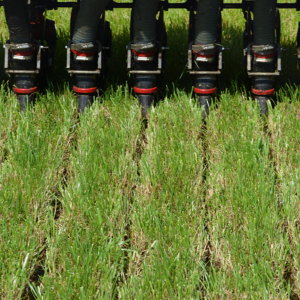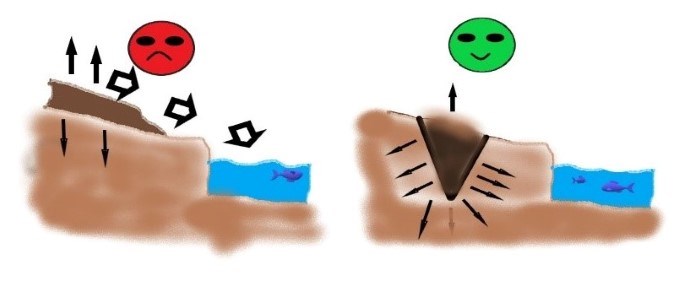Subsurface manure application

In-furrow subsoil application of liquid manure is a measure that reduces emissions of ammonia from manure by reducing the time of contact to the open air. The measure also reduces the risk for surface runoff of the manure.
Subsurface application of liquid organic fertilizer based on manure under pressure into the grooves is a measure that makes it possible to increase soil fertility and improve soil structure, regardless of the type of soil.
In liquid organic fertilizer, nitrogen is in a more accessible form for plants than in solid fertilizer, and its introduction into the root zone allows the most efficient use of the potential of fertilizers. The placement of fertilizers inside the soil, in less dense soil layers, under the surface soil crust accelerates the process of fertilizer infiltration, which excludes the formation of fertilizers on the soil surface, therefore, the risk of surface runoff of nutrients into water bodies is reduced. Surface washout of fertilizers into water bodies is one of the main sources of nutrients.
Subsurface application of liquid organic fertilizer based on manure under pressure into the grooves gives an advantage both in terms of reducing emissions into the atmosphere and water bodies, and the farmer receives preferences by reducing the need to purchase mineral fertilizers, increasing soil fertility and obtaining large yields of crop products, including in meadows and pastures. Also liquid organic fertilizer is an additional source of moisture during dry periods of the year.
Localisation and implementation
This method is intended for use on grassland or arable land with minimal tillage before planting and after harvest (Figure 1). The method is used in almost all countries, but has some limitations: the method is less effective on very stony or on very thin or compacted soils, where it is impossible to ensure uniform penetration to the required working depth. Systems for applying liquid organic fertilizer under pressure are more energy intensive than surface or belt application equipment. The application rates vary depending on the characteristics of the fertilizers, the crops grown and the degree of soil fertility.

Effects, duration and maintenance
Accelerated assimilation of nutrients from fertilizers by plants, soil and exclusion of surface runoff, reduce nitrogen emissions and phosphorus input into water bodies. The potential to increase productivity and reduce emissions and runoff are the main results of subsurface application.
The effect is long-term if soil condition during implementation is optimal. After incorporation, no maintenance is needed.

Subsurface manure application - extended description
Description
In-furrow subsoil application of a liquid organic manure-based fertiliser under pressure is a measure aimed at reducing the time of contact between fertilisers and the open air and at their immediate spread in the root zone within the plow layer. The spread of fertilisers within the soil helps accelerate its infiltration and the binding of nutrients through microbiological processes, which substantially reduces the risk of their surface runoff to ground waters and surface water bodies, while cutting gas emissions (of ammonia, hydrogen sulfide etc.) to the atmosphere.
In-furrow subsoil application of a liquid organic manure-based fertiliser under pressure is a measure intended to enhance soil fertility and improve the structure of soil regardless of its type. In liquid organic fertilisers, nitrogen is more available to plants than in solid ones, and by placing it in the root zone one can make a more effective use of the potential of fertilisers. Subsurface application to the less dense soil layers, under the surface crust, accelerates fertiliser infiltration, preventing the accumulation of the fertiliser on the surface and, hence, reducing the risk of biogens draining from the surface to water bodies. Surface runoff of fertilisers into water bodies makes one of the main sources of biogens.
In-furrow subsoil application of a liquid organic fertiliser under pressure is beneficial from the point of view of cutting emissions both to the atmosphere and to water bodies, and provides farmers with certain preferences by sparing them the need to buy mineral fertilisers, enhancing soil fertility and ensuring larger crop yields, including in meadows and pastures. Liquid organic fertilisers can also serve as an additional source of moisture during dry spells. This measure shows the best effect in crop production in floodplain areas.
Localisation and implementation
This method is intended to be used at pastures or arable lands with minimum tillage before sowing and after harvesting. It can be applied in nearly all countries, with some restrains, though: it is less effective in highly shallow or compacted soils, where application cannot be done uniformly to the required working depth. Systems for application of liquid organic fertilisers under pressure are more energy-intensive than equipment for surface or band placement. Dosage varies depending on the characteristics of fertilisers, crops and fertility level.
Restrains include high stoniness of soil, since stones can damage the implements, and fields with steep slopes, which can topple the application equipment. Moreover, when slopes are steep, liquid organic fertilisers will not get absorbed through the soil fast enough, leading to surface runoff.
Natural and climatic restrains are as follows:
- sub-zero air temperatures, since the fertiliser can freeze;
- high solar radiation, since the fertiliser can evaporate to a greater extent than seep through the soil, which increases emissions to the atmospheric air (this effect is less apparent in the case of this method compared to surface application);
- abundant rainfall and waterlogged soil, since the speed of infiltration of liquid fertilisers goes down and they can drain away to water bodies together with rainwater.
The implements used to form the furrows commonly include a disc (one or two), different types of cultivators (duck foot blades etc.) (Figure 2). To make the method more effective, rollers can be used to cover the furrows after placement.

Effects, duration and maintenance
A faster nutrient uptake by plants and soil, coupled with the prevention of surface runoff, reduces nitrogen emissions and escape of phosphorus into water bodies. The main potential of subsoil application is enhancing capability and cutting emissions.
Major investment costs for implementing this method are related to the purchase of a tractor and a fertiliser application machine. Depending on the manufacturer, performance and lifting capacity of the type of the implements used, average unit prices in Russia vary from EUR 25,000 to 130,000 and higher. The mean service life established by the manufacturer is up to 10 years, and annual expenses generally comprise operational expenses, notably on repair and maintenance of equipment, payroll, fuel etc. The frequency and scope of repairs is determined by the manufacturer.
- The use of liquid organic fertilisers in the root zone increases populations of microorganisms.
- The use of rational doses of fertilisers in optimal weather conditions prevents the release of nutrients into ground waters and slashes emissions to water bodies compared to surface placement.
- The application of this method helps reduce atmospheric emissions arising from the use of organic fertilisers compared to surface placement.
The effect is long-term if soil condition during implementation is optimal. After incorporation, no maintenance is needed.
Subsurface manure application - links to resources
Pamphlets, reports, videos and websites
-
Scientific papers
Васильев Э.В. Повышение эколого-экономической эффективности процесса использования жидкого органического удобрения путем автоматизированного выбора рациональных вариантов технологий транспортировки и внесения в условиях Северо-Западного региона (Increasing the ecological and economic efficiency of the process of using liquid organic fertilisers by automated selection of rational options for transportation and application technologies in the conditions of the Northwest region). Bulletin of the All-Russian Scientific Research Institute of Livestock Mechanization: Вестник Всероссийского научно-исследовательского института механизации животноводства: 2013. No. 4(12). pp. 127-133. (In Russian)
Authors:
Eduard Vasilev, Aleksandr Briukhanov, Ekaterina Shalavina and Ekaterina Vorobyeva. Federal Scientific Agriengineering Centre VIM, St Petersburg, Russia.
Contact:
Eduard Vasilev, Federal Scientific Agriengineering Centre VIM, St Petersburg, Russia.

